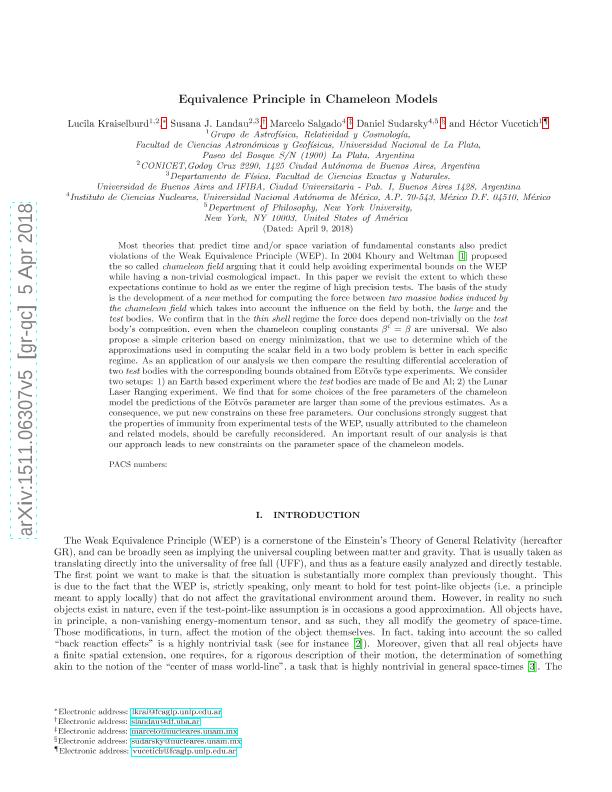Mostrar el registro sencillo del ítem
dc.contributor.author
Kraiselburd, Lucila

dc.contributor.author
Landau, Susana Judith

dc.contributor.author
Salgado, Marcelo

dc.contributor.author
Sudarsky, Daniel
dc.contributor.author
Vucetich, Hector

dc.date.available
2020-03-04T20:35:06Z
dc.date.issued
2018-05
dc.identifier.citation
Kraiselburd, Lucila; Landau, Susana Judith; Salgado, Marcelo; Sudarsky, Daniel; Vucetich, Hector; Equivalence principle in chameleon models; American Physical Society; Physical Review D; 97; 10; 5-2018; 1-35; 104044
dc.identifier.issn
2470-0029
dc.identifier.uri
http://hdl.handle.net/11336/98807
dc.description.abstract
Most theories that predict time and/or space variation of fundamental constants also predict violations of the weak equivalence principle (WEP). In 2004 Khoury and Weltman [1] proposed the so called chameleon field arguing that it could help avoiding experimental bounds on the WEP while having a nontrivial cosmological impact. In this paper we revisit the extent to which these expectations continue to hold as we enter the regime of high precision tests. The basis of the study is the development of a new method for computing the force between two massive bodies induced by the chameleon field which takes into account the influence on the field by both, the large and the test bodies. We confirm that in the thin shell regime the force does depend nontrivially on the test body's composition, even when the chameleon coupling constants βi=β are universal. We also propose a simple criterion based on energy minimization, that we use to determine which of the approximations used in computing the scalar field in a two body problem is better in each specific regime. As an application of our analysis we then compare the resulting differential acceleration of two test bodies with the corresponding bounds obtained from Eötvös type experiments. We consider two setups: (1) an Earth based experiment where the test bodies are made of Be and Al; (2) the Lunar Laser Ranging experiment. We find that for some choices of the free parameters of the chameleon model the predictions of the Eötvös parameter are larger than some of the previous estimates. As a consequence, we put new constrains on these free parameters. Our conclusions strongly suggest that the properties of immunity from experimental tests of the WEP, usually attributed to the chameleon and related models, should be carefully reconsidered. An important result of our analysis is that our approach leads to new constraints on the parameter space of the chameleon models.
dc.format
application/pdf
dc.language.iso
eng
dc.publisher
American Physical Society

dc.rights
info:eu-repo/semantics/openAccess
dc.rights.uri
https://creativecommons.org/licenses/by-nc-sa/2.5/ar/
dc.subject
COSMOLOGY
dc.subject
FIELDS
dc.subject
GRAVITY
dc.subject
TEST
dc.subject.classification
Astronomía

dc.subject.classification
Ciencias Físicas

dc.subject.classification
CIENCIAS NATURALES Y EXACTAS

dc.title
Equivalence principle in chameleon models
dc.type
info:eu-repo/semantics/article
dc.type
info:ar-repo/semantics/artículo
dc.type
info:eu-repo/semantics/publishedVersion
dc.date.updated
2019-10-22T17:41:54Z
dc.journal.volume
97
dc.journal.number
10
dc.journal.pagination
1-35; 104044
dc.journal.pais
Estados Unidos

dc.description.fil
Fil: Kraiselburd, Lucila. Consejo Nacional de Investigaciones Científicas y Técnicas. Centro Científico Tecnológico Conicet - La Plata. Instituto de Astrofísica La Plata. Universidad Nacional de La Plata. Facultad de Ciencias Astronómicas y Geofísicas. Instituto de Astrofísica La Plata; Argentina
dc.description.fil
Fil: Landau, Susana Judith. Consejo Nacional de Investigaciones Científicas y Técnicas. Oficina de Coordinación Administrativa Ciudad Universitaria. Instituto de Física de Buenos Aires. Universidad de Buenos Aires. Facultad de Ciencias Exactas y Naturales. Instituto de Física de Buenos Aires; Argentina
dc.description.fil
Fil: Salgado, Marcelo. Universidad Nacional Autónoma de México. Instituto de Ciencias Nucleares; México
dc.description.fil
Fil: Sudarsky, Daniel. Universidad Nacional Autónoma de México. Instituto de Ciencias Nucleares; México. University of New York; Estados Unidos
dc.description.fil
Fil: Vucetich, Hector. Consejo Nacional de Investigaciones Científicas y Técnicas. Centro Científico Tecnológico Conicet - La Plata. Instituto de Astrofísica La Plata. Universidad Nacional de La Plata. Facultad de Ciencias Astronómicas y Geofísicas. Instituto de Astrofísica La Plata; Argentina
dc.journal.title
Physical Review D

dc.relation.alternativeid
info:eu-repo/semantics/altIdentifier/url/https://link.aps.org/doi/10.1103/PhysRevD.97.104044
dc.relation.alternativeid
info:eu-repo/semantics/altIdentifier/doi/http://dx.doi.org/10.1103/PhysRevD.97.104044
dc.relation.alternativeid
info:eu-repo/semantics/altIdentifier/url/https://arxiv.org/abs/1511.06307
Archivos asociados
